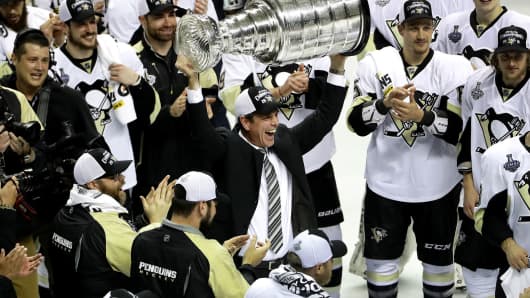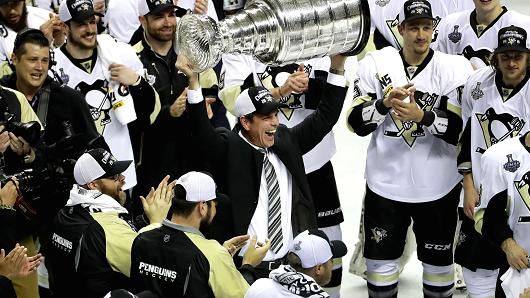
Long before I was a successful CEO, I was an athlete. I may not have been destined for the NFL, but I learned a lot from my years as a player, and I like to think my coaches and teammates valued my contribution. Even today I count among my friends those who did make it to the elite levels of sport.
I played many sports, but in particular, I was a receiver and team captain at the college football level in Ontario, Canada. I was a great fit for the University of Guelph Gryphon squad, which had a culture of team before individual goals, aggressiveness and old-fashioned hard work. My coach, Dan McNally, taught me that life and sports aren’t fair and that those who are prepared to make personal sacrifices and prepare better than their competitors will succeed.
In my professional field of executive recruiting, I began to focus on culture and recruiting for fit because I saw how vital that was to maintaining a competitive advantage. In many ways, the best practices to find great talent, recruit it and keep it aren’t all that different from the measures used by the world’s most elite sports franchises.
Here are three lessons from three off-the-field sports geniuses — the general managers and coaches of pro teams — that can serve as models for ‘business athletes.’
1. When recruiting talent, buy-in for your vision is essential.
Example: Lou Lamoriello, National Hockey League general manager
Whether a solo athlete building the team around you, or a manager building your team of athletes, recruiting for fit is the most important step you’ll ever take toward success. The master of this in modern times is NHL General Manager Lou Lamoriello, who is currently rebuilding the Toronto Maple Leafs.
From 1987 to 2015, Lamoriello was the GM of the New Jersey Devils hockey club, where he developed a reputation as a shrewd negotiator, a long-game thinker and, of course, the creator of the dynasty that won three Stanley Cups. However, in hockey as in business, it isn’t just about recruiting superstars. Recruiting for fit, in both business and sports, is key. In Lamoriello’s case, he built a team around his vision of defense-based play, so what fit with his vision were players who aligned with that vision, such as star goalie Martin Brodeur.
When I asked Lamoriello about this, he told me having your team buy into your vision is vital.
“If you don’t get the participants’ buy-in, then it doesn’t flourish,” Lamoriello said, “They don’t necessarily have to agree, but they do have to embrace it.”
A good example of this from the corporate world is HR software giant Ceridian HCM, one of our clients, which has perfected a recruiting strategy to help make sure prospective team members will buy into their culture. It begins right in the interview process. “Ceridian managers will often ask about interests outside of work,” said David Ossip, chairman and CEO of Ceridian, “The best candidates are able to provide differentiated answers that help clarify and underscore their character and values.”
2. Even stars need to go — no questions asked — when they cross the line.
Example: Thomas Dimitroff, Atlanta Falcons general manager
Once you have your roster, you need to hold your team members accountable. Even your star players.
Consider the case of one of my former college football teammates, Thomas Dimitroff. Dimitroff is the general manager of the Atlanta Falcons football team. His tenure coincided with the Michael Vick situation. The star quarterback was charged and convicted in relation to an organized dogfighting operation. He was also immensely popular and talented.
I asked Dimitroff, What do you do — what does any business do — with a star player whose behavior does not align with the organization’s culture?
Vick never played another game for the Falcons, and Dimitroff’s answer was very straightforward: “Marty, we cut him. We get rid of him. Right away. No questions asked.” The Falcons ultimately released Vick after failing to trade him.
More from iCONIC:
12 of the most famous Harvard grads—and dropouts—of modern time
Bogle: What I learned from my biggest investing mistake
How 9 iconic American brands discovered their names
It’s a tough call in sports, as it is in business. However, you have to hold your people, even your best people, accountable if you want your culture to remain a competitive advantage.
A good example of this from the business world is CN Rail. Legendary railroad executive Hunter Harrison had a tough job when he took over operations. The organization was known for allowing “early quits,” where staff members would work for four hours but get paid for eight. After visiting one of CN’s terminals in Battle Creek, Michigan, Harrison discovered most of the staff had already left for the day. He was unimpressed, to say the least.
“I said that afternoon, ‘Stop it. Stop it today. Right now,’ all over the system. It’s grounds for dismissal for any operating supervisor or officer of the company that allows this to go on,” Harrison recalled. CN is one of the all-time success stories of corporate-culture change, because they held their people accountable even when it was tough, and they got results.
3. Command-and-control is out. Great communicators are blunt, but that doesn’t mean they do not care about individuals.
Example: Mike Sullivan, Pittsburgh Penguins coach
It’s no secret that great communication is key in a successful business and a successful sports team. What is new is that the style of communication that makes for success is changing, and it’s changing in similar ways in both sports and business. Nowhere was this more apparent than in the 2016 Stanley Cup finals.
At the season’s halfway point, the Pittsburgh Penguin’s record was 15–10–3. This team, with so much skill and so much speed, looked lethargic. Sidney Crosby was having the worst first half of his career. The GM brought in a new coach, Mike Sullivan, partway through the season. One of this coach’s best qualities, by all accounts, is his great communication ability. He’s blunt, but he cares. By clearly articulating what his expectations were and where the team was going, he managed to rein in many of the problems from the first half of the season and create a resilient team. He clearly connected with each member of the group, from now-grizzled veteran Sidney Crosby to young players like Bryan Rust.
In business and in sports, the “command and control” style of communication simply doesn’t work anymore. We have raised a generation of people who don’t respond well to this. On this point, Sullivan said, “I think it’s important that we create an environment here that we inspire people to play. And for me that energy has to start well before the puck drops.”
The 2016 Stanley Cup winners, the Pittsburgh Penguins turned themselves around because they had a leader they felt engaged with. In the corporate world a leader who is able to communicate in a way that enhances engagement will find similar success.
[Source:-CNBC]





